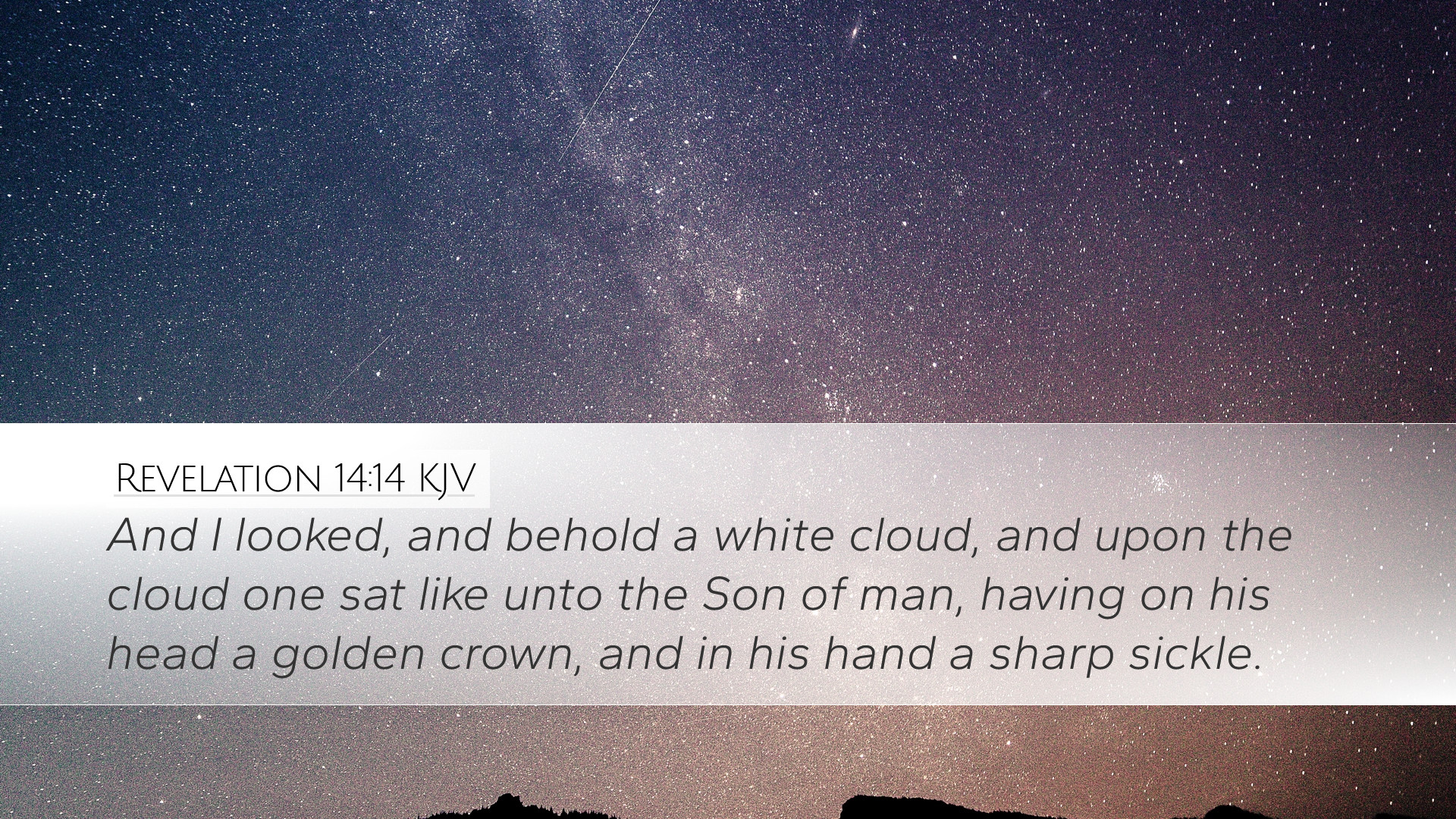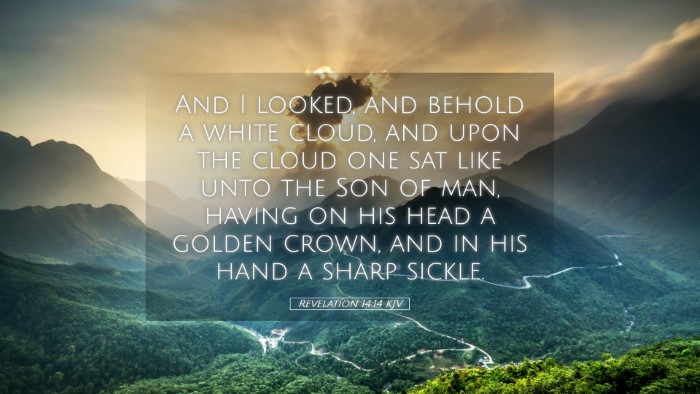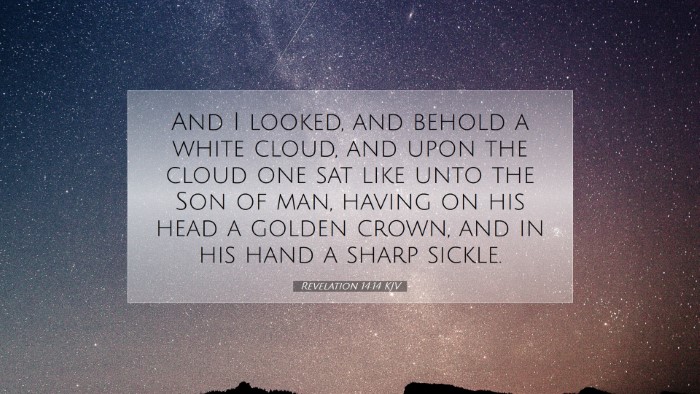Commentary on Revelation 14:14
Revelation 14:14 (KJV): "And I looked, and behold a white cloud, and upon the cloud one sat like unto the Son of man, having on his head a golden crown, and in his hand a sharp sickle."
Introduction
The vision of Revelation 14:14 presents an exalted and significant moment in the apocalyptic narrative. It symbolizes the divine authority and the impending judgment associated with the second coming of Christ. This commentary brings together insights from renowned public domain commentators — Matthew Henry, Albert Barnes, and Adam Clarke — offering a comprehensive examination of this verse's layers of meaning.
Overview of the Verse
This verse introduces a scene in which John, the author of Revelation, observes a figure upon a white cloud, described distinctly as "like unto the Son of man." The presence of a golden crown and a sharp sickle indicates authority and impending harvest—reflecting themes of judgment and salvation.
Examination of Key Elements
1. The White Cloud
The white cloud symbolizes divine presence and glory, as noted by Clarke, who emphasizes that clouds often represent God's majesty in Scripture. Henry elaborates, observing that the whiteness of the cloud correlates with purity, further underscoring the holiness of Christ as He approaches to execute judgment.
2. The Figure Like unto the Son of Man
This phrase is notably significant, as it links the figure to Jesus Christ. We discern from Barnes that the "Son of man" title emphasizes Christ's dual identity as both divine and human, suggesting His capability to judge in righteousness. Clarke notes that this title reflects Christ’s humble incarnation, indicating His relatability to humanity while still possessing sovereign authority.
3. The Golden Crown
The golden crown signifies victory and sovereignty. Matthew Henry explains that it indicates the royalty of Christ, distinguishing Him as the King of Kings. It reflects fulfillment of prophecies concerning Christ's exaltation and His role as the ultimate judge over nations. This crown symbolizes not just authority but also the prosperity that comes from divine favor.
4. The Sharp Sickle
The sharp sickle is a potent symbol of harvest, often associated with the gathering of souls for judgment. Barnes elucidates that the sickle represents the execution of God’s judgment, where the faithful are separated from the unfaithful, affirming the notion of divine reckoning. Henry adds that the sickle's sharpness emphasizes the decisiveness and urgency of the impending judgment day.
Theological Implications
1. Christ's Authority in Judgment
In this verse, we see a profound demonstration of Christ's authority over creation. The image of Him seated upon the cloud indicates His position as sovereign judge. Clarke posits that this reinforces a core tenet of Christian belief: Jesus will return in grandeur to judge the living and the dead, a hope for believers and a warning to the unrepentant.
2. The Harvest of Souls
The harvest metaphor serves as a reminder of the necessity for spiritual readiness. As noted by Henry, this scene is a call to vigilance for believers, underscoring the truth that the Lord will gather His people, but also will execute judgment on those who have rejected His grace. The evocative nature of harvest invites reflection on one’s own spiritual state.
3. Hope and Assurance for Believers
For the faithful, Revelation 14:14 offers tremendous hope and assurance. The imagery encapsulates a promise that Christ will return victoriously, signifying deliverance for those who endure. Barnes highlights that the second coming isn't merely a foreboding of judgment but also serves to instill hope within Christians, affirming God’s ultimate victory over evil.
Practical Applications
1. Encouragement of Faithfulness
Believers are called to remain steadfast in faith and practice. The promise of Christ's return should motivate them to live righteously, as the imminent return of the “Son of man” signifies that every action bears eternal consequences. Clarke stresses that this expectation should cultivate a sense of urgency in spiritual pursuits.
2. Anticipating Christ's Return
Pastors and church leaders should teach congregations about the importance of living in anticipation of Christ's second coming. This can lead to greater outreach efforts and evangelism, echoing Henry’s point that believers should cultivate a harvest mindset, recognizing the urgency of bringing others to Christ before judgment arrives.
3. Spiritual Reflection and Readiness
This verse invites all, especially theologians and scholars, to engage in deep spiritual reflection regarding their own lives and teachings. The reminder of the sharp sickle serves as a call for introspection about personal and communal spiritual readiness. Barnes suggests regular self-examination in light of this prophecy, emphasizing the need for repentance and spiritual growth.
Conclusion
Revelation 14:14 encapsulates a powerful vision filled with rich symbolism, profound theological implications, and practical applications for believers. Drawing from the insights of Matthew Henry, Albert Barnes, and Adam Clarke, this commentary highlights the majesty of Christ as the divine judge, the urgency of spiritual preparedness, and the hope that His return brings to the faithful. As the church anticipates His coming, may we be encouraged to remain vigilant, as faithful stewards of the gospel, actively participating in the great harvest before Him.


